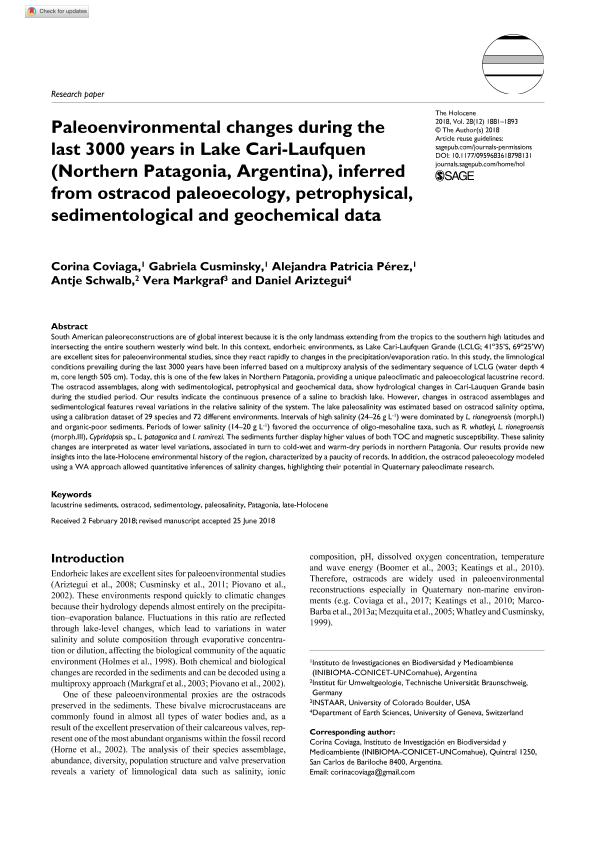Mostrar el registro sencillo del ítem
dc.contributor.author
Coviaga, Corina Anabel

dc.contributor.author
Cusminsky, Gabriela Catalina

dc.contributor.author
Perez, Alejandra Patricia

dc.contributor.author
Schwalb, Antje
dc.contributor.author
Markgraf, Vera

dc.contributor.author
Ariztegui, Daniel
dc.date.available
2020-02-10T20:19:08Z
dc.date.issued
2018-08
dc.identifier.citation
Coviaga, Corina Anabel; Cusminsky, Gabriela Catalina; Perez, Alejandra Patricia; Schwalb, Antje; Markgraf, Vera; et al.; Paleoenvironmental changes during the last 3000 years in Lake Cari-Laufquen (Northern Patagonia, Argentina), inferred from ostracod paleoecology, petrophysical, sedimentological and geochemical data; SAGE Publications; Holocene (Seven Oaks); 28; 2; 8-2018; 1881-1893
dc.identifier.issn
0959-6836
dc.identifier.uri
http://hdl.handle.net/11336/97115
dc.description.abstract
South American paleoreconstructions are of global interest because it is the only landmass extending from the tropics to the southern high latitudes and intersecting the entire southern westerly wind belt. In this context, endorheic environments, as Lake Cari-Laufquen Grande (LCLG; 41º35’S, 69º25’W) are excellent sites for paleoenvironmental studies, since they react rapidly to changes in the precipitation/evaporation ratio. In this study, the limnological conditions prevailing during the last 3000 years have been inferred based on a multiproxy analysis of the sedimentary sequence of LCLG (water depth 4 m, core length 505 cm). Today, this is one of the few lakes in Northern Patagonia, providing a unique paleoclimatic and paleoecological lacustrine record. The ostracod assemblages, along with sedimentological, petrophysical and geochemical data, show hydrological changes in Cari-Lauquen Grande basin during the studied period. Our results indicate the continuous presence of a saline to brackish lake. However, changes in ostracod assemblages and sedimentological features reveal variations in the relative salinity of the system. The lake paleosalinity was estimated based on ostracod salinity optima, using a calibration dataset of 29 species and 72 different environments. Intervals of high salinity (24–26 g L-1) were dominated by L. rionegroensis (morph.I) and organic-poor sediments. Periods of lower salinity (14–20 g L-1) favored the occurrence of oligo-mesohaline taxa, such as R. whatleyi, L. rionegroensis (morph.III), Cypridopsis sp., L. patagonica and I. ramirezi. The sediments further display higher values of both TOC and magnetic susceptibility. These salinity changes are interpreted as water level variations, associated in turn to cold-wet and warm-dry periods in northern Patagonia. Our results provide new insights into the late-Holocene environmental history of the region, characterized by a paucity of records. In addition, the ostracod paleoecology modeled using a WA approach allowed quantitative inferences of salinity changes, highlighting their potential in Quaternary paleoclimate research.
dc.format
application/pdf
dc.language.iso
eng
dc.publisher
SAGE Publications

dc.rights
info:eu-repo/semantics/openAccess
dc.rights.uri
https://creativecommons.org/licenses/by-nc-sa/2.5/ar/
dc.subject
LACUSTRINE SEDIMENTS
dc.subject
LATE-HOLOCENE
dc.subject
OSTRACOD
dc.subject
PALEOSALINITY
dc.subject
PATAGONIA
dc.subject
SEDIMENTOLOGY
dc.subject.classification
Ciencias Medioambientales

dc.subject.classification
Ciencias de la Tierra y relacionadas con el Medio Ambiente

dc.subject.classification
CIENCIAS NATURALES Y EXACTAS

dc.title
Paleoenvironmental changes during the last 3000 years in Lake Cari-Laufquen (Northern Patagonia, Argentina), inferred from ostracod paleoecology, petrophysical, sedimentological and geochemical data
dc.type
info:eu-repo/semantics/article
dc.type
info:ar-repo/semantics/artículo
dc.type
info:eu-repo/semantics/publishedVersion
dc.date.updated
2019-10-10T13:57:37Z
dc.journal.volume
28
dc.journal.number
2
dc.journal.pagination
1881-1893
dc.journal.pais
Estados Unidos

dc.description.fil
Fil: Coviaga, Corina Anabel. Consejo Nacional de Investigaciones Científicas y Técnicas. Centro Científico Tecnológico Conicet - Patagonia Norte. Instituto de Investigaciones en Biodiversidad y Medioambiente. Universidad Nacional del Comahue. Centro Regional Universidad Bariloche. Instituto de Investigaciones en Biodiversidad y Medioambiente; Argentina
dc.description.fil
Fil: Cusminsky, Gabriela Catalina. Consejo Nacional de Investigaciones Científicas y Técnicas. Centro Científico Tecnológico Conicet - Patagonia Norte. Instituto de Investigaciones en Biodiversidad y Medioambiente. Universidad Nacional del Comahue. Centro Regional Universidad Bariloche. Instituto de Investigaciones en Biodiversidad y Medioambiente; Argentina
dc.description.fil
Fil: Perez, Alejandra Patricia. Consejo Nacional de Investigaciones Científicas y Técnicas. Centro Científico Tecnológico Conicet - Patagonia Norte. Instituto de Investigaciones en Biodiversidad y Medioambiente. Universidad Nacional del Comahue. Centro Regional Universidad Bariloche. Instituto de Investigaciones en Biodiversidad y Medioambiente; Argentina
dc.description.fil
Fil: Schwalb, Antje. Technische Universität Braunschweig; Alemania
dc.description.fil
Fil: Markgraf, Vera. State University of Colorado at Boulder; Estados Unidos
dc.description.fil
Fil: Ariztegui, Daniel. Universidad de Ginebra; Suiza
dc.journal.title
Holocene (Seven Oaks)

dc.relation.alternativeid
info:eu-repo/semantics/altIdentifier/doi/http://dx.doi.org/10.1177/0959683618798131
dc.relation.alternativeid
info:eu-repo/semantics/altIdentifier/url/https://journals.sagepub.com/doi/10.1177/0959683618798131
Archivos asociados
